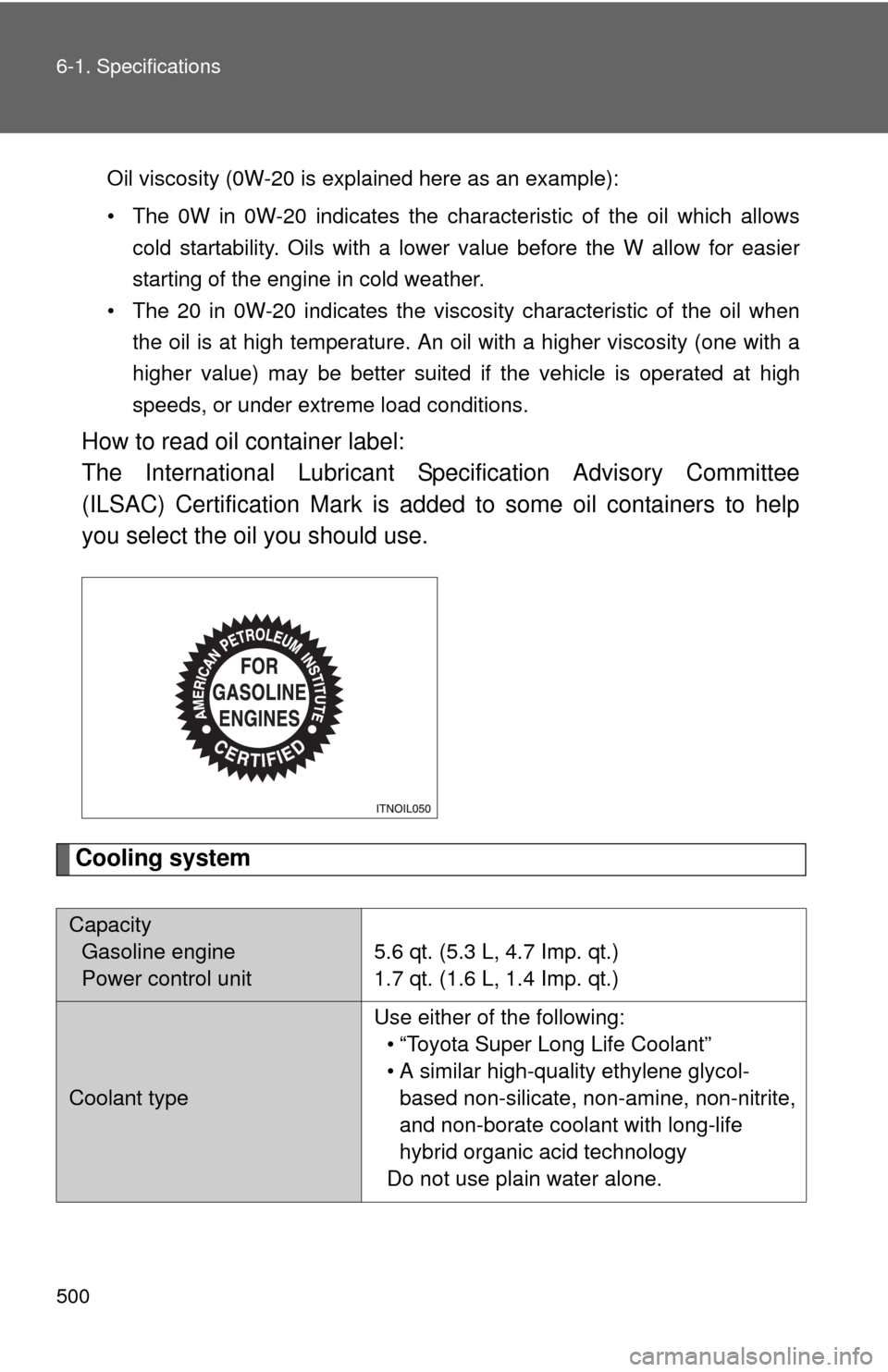Page 451 of 563
448 5-2. Steps to take in an emergency
Stop the vehicle immediately.The following warning indicates the possibility of damage to the vehi-
cle that may lead to an accident. Immediately stop the vehicle in a
safe place and contact your Toyota dealer.
Warning messageDetails
Indicates a malfunction in the hybrid system
A buzzer sounds in accordance with the warning
message that is displayed.
Indicates that the high engine coolant tempera-
ture is too high
Indicates abnormal engine oil pressure
A buzzer also sounds.
The warning message is shown if the engine oil
pressure is too low.
Page 490 of 563
5
When trouble arises
487
5-2. Steps to take in an emergency
If your vehicle overheats
Correction procedures■ If is shown on the mu lti-information display
Stop the vehicle in a safe place and turn off the air condition-
ing system, and then stop the hybrid system.
If you see steam: Carefully lift the hood after the steam subsides.
If you do not see steam: Carefully lift the hood.
After the hybrid system has
cooled down sufficiently, inspect
the hoses and radiator core
(radiator) for any leaks.
Radiator
Cooling fan
If a large amount of coolant leaks,
immediately contact your Toyota
dealer.
The following may indicate that your vehicle is overheating.
● ( P. 448) is shown on the multi-information display.
● The hybrid system overheat warning message ( P. 452) is
shown on the multi-information display.
● Steam comes out from under the hood.
STEP1
STEP2
STEP3
Page 491 of 563
488 5-2. Steps to take in an emergency
The coolant level is satisfactory if
it is between the “FULL” and
“LOW” lines on the reservoir.Reservoir
“FULL”
“LOW”
Add coolant if necessary.
Water can be used in an emer-
gency if coolant is unavailable.
Start the hybrid system and turn the air conditioning system
on to check that the radiator cooling fan operates and to
check for coolant leaks from the radiator or hoses.
The fan operates when the air conditioning system is turned on
immediately after a cold start. Confirm that the fan is operating by
checking the fan sound and air flow. If it is difficult to check these,
turn the air conditioning system on and off repeatedly.
(The fan may not operate in freezing temperatures.)
If the fan is not operating: Stop the hybrid system im mediately and contact your
Toyota dealer.
If the fan is operating: Have the vehicle inspected at the nearest Toyota dealer.
STEP4
STEP5
STEP6
STEP7
Page 492 of 563
5
When trouble arises
489
5-2. Steps to take in an emergency
■
If the hybrid system overheat warning message is shown on
the multi-information display
Stop the vehicle in a safe place.
Stop the hybrid system and carefully lift the hood.
After the hybrid system has
cooled down, inspect the hoses
and radiator core (radiator) for
any leaks.
Radiator
Cooling fan
If a large amount of coolant leaks,
immediately contact your Toyota
dealer.
The coolant level is satisfactory if
it is between the “F” and “L” lines
on the reservoir.Reservoir
“F”
“L”
Add coolant if necessary.
Water can be used in an emer-
gency if coolant is unavailable.
STEP1
STEP2
STEP3
STEP4
STEP5
Page 493 of 563

490 5-2. Steps to take in an emergency
Start the hybrid system and check for the multi-information
display.
If the message does not disappear:Stop the hybrid system and c ontact your Toyota dealer.
If the message is not displayed: Have the vehicle inspected at the nearest Toyota dealer.
CAUTION
■To prevent an accident or injury when inspecting under the hood of
your vehicle
● If steam is seen coming from under the hood, do not open the hood until
the steam has subsided. The engine compartment may be very hot, caus-
ing serious injuries such as burns.
● After the hybrid system has been turned off, check that on the
multi-information display and the “READY” indicator are off.
When the hybrid system is operating, the gasoline engine may automati-
cally start, or the cooling fan may suddenly operate even if the gasoline
engine stops. Do not touch or approach rotating parts such as the fan,
which may lead to fingers or clothing (especially a tie, a scarf or a muffler)
getting caught, resulting in serious injury.
● Do not loosen the radiator cap while the hybrid system and radiator are
hot.
Serious injuries, such as burns, may result from hot coolant and steam
released under pressure.
STEP6
Page 494 of 563
5
When trouble arises
491
5-2. Steps to take in an emergency
NOTICE
■
When adding engine/power control unit coolant
Wait until the hybrid system has cooled down before adding engine/power
control unit coolant.
When adding coolant, do so slowly. Adding cool coolant to a hot hybrid sys-
tem too quickly can cause damage to the hybrid system.
■ To prevent damage to the cooling system
Observe the following precautions:
●Avoid contaminating the coolant with foreign matter (such as sand or dust
etc.).
● Do not use any coolant additive.
Page 503 of 563

500 6-1. Specifications
Oil viscosity (0W-20 is explained here as an example):
• The 0W in 0W-20 indicates the characteristic of the oil which allowscold startability. Oils with a lower value before the W allow for easier
starting of the engine in cold weather.
• The 20 in 0W-20 indicates the viscosity characteristic of the oil when the oil is at high temperature. An oil with a higher viscosity (one with a
higher value) may be better suited if the vehicle is operated at high
speeds, or under extreme load conditions.
How to read oil container label:
The International Lubricant Spec ification Advisory Committee
(ILSAC) Certification Mark is added to some oil containers to help
you select the oil you should use.
Cooling system
Capacity Gasoline engine
Power control unit 5.6 qt. (5.3 L, 4.7 Imp. qt.)
1.7 qt. (1.6 L, 1.4 Imp. qt.)
Coolant type Use either of the following:
• “Toyota Super Long Life Coolant”
• A similar high-quality ethylene glycol-based non-silicate, non-amine, non-nitrite,
and non-borate coolant with long-life
hybrid organic acid technology
Do not use plain water alone.
Page 519 of 563

516 6-1. Specifications
Glossary of tire terminology
Tire related termMeaning
Cold tire inflation pres-
sure Tire pressure when the vehicle has been
parked for three hours or more, or has not
been driven more than 1 mile or 1.5 km under
that condition
Maximum inflation
pressure The maximum cold inflated
pressure to which a
tire may be inflated, s hown on the sidewall of
the tire
Recommended infla-
tion pressure Cold tire inflation pressure recommended by a
manufacturer
Accessory weight The combined weight (in excess of those stan-
dard items which may be replaced) of hybrid
transmission, power steering, power brakes,
power windows, power seats, radio and heater,
to the extent that these items are available as
factory-installed equipment (whether installed
or not)
Curb weight The weight of a motor vehicle with standard
equipment, including the maximum capacity of
fuel, oil and coolant, and if so equipped, air
conditioning and additional weight optional
engine
Maximum loaded vehi-
cle weight The sum of:
(a) Curb weight
(b) Accessory weight
(c) Vehicle capacity weight
(d) Production options weight
Normal occupant
weight 150 lb. (68 kg) times the number of occupants
specified in the second co
lumn of Table 1* that
follows
Occupant distribution Distribution of occupants in a vehicle as speci-
fied in the third column of Table 1* below